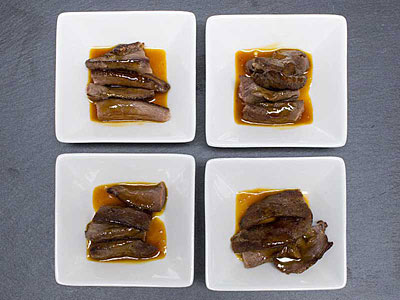October 24, 2011
Amuse-Bouche

filet mignon de canard
(duck tenderloin)
Every domestic bird has two. Without one for each wing, the wing wouldn’t work. When we open a package of chicken breasts, these maybe included, or maybe not. What is it? The m. pectoralis profundus, or as sometimes called, the pectoral minor muscle. In a chicken, it is sometimes marketed as a “chicken finger” or a “chicken tenderloin.”
Unlike the tenderloin in a bovine, porcine, or ovine example, which is a lightly used muscle along the back, and ventral to the lateral process of the lumbar spine, the “tenderloin” on poultry is a breast muscle. The large breast muscle purchased boneless and skinless on a Styrofoam tray is the pectoral major muscle. The small muscle that sits against the sternum and is dorsal to the pectoral major is the pectoral minor. The two are separated by the coracoclavicular membrane. A tendon runs the whole length of the pectoral minor muscle. It’s cranial end passes through a space in the shoulder joint called the triosseum foramen and attaches to the lateral tuberosity of the humerus, sort of a lever-pulley system to lift the wing.
Each time I purchase a package of Moulard duck breasts, there’s two of these little meaty morsels attached to the breasts, but barely. Each package contains two half breasts, in other words, a set of muscles from each side of the sternum. The half breasts weigh about 450 g (1⁄2 lb) each. The little “tenderloin” attached to the bottom side weighs maybe 25 g (not quite an ounce). There’s a little of the coracoclavicular membrane holding the two together, and they can easily be separated with light pulling.
Unlike on a chicken or turkey, the tendon that runs down through the center of the pectoral minor muscle on a duck clearly divides it into two separate strips. This means that the tendon cannot be totally removed without separating the muscle into two pieces, which I want to avoid. I try to just remove the thick portion of the tendon where it extends from the muscle to where it was attached to the shoulder. When laid out flat on my cutting board. The muscle is about 20 cm (8 in) long, 2 cm (8⁄10 in) wide, and 3 mm (1⁄8 in) thick at its chubbiest point. When cooked, the muscle will substantially shrink in length and fatten up a bit.
To cook it, I heat some fat—duck fat, clarified butter, vegetable oil, or whatever is handy—in a small frying pan over very high heat. The meat is seasoned lightly with fine salt and freshly ground black pepper. When the fat is very hot, the meat is added and each strip is stretched out its full length. When the first side is seared, each strip is flipped and the second side seared. This all takes less than 30 seconds. The meat is drained on paper towels while the sauce is finished.
(I actually start the sauce before the meat.) I juice an orange or two and reduce the juice to a syrup. Then while the meat is searing, I’ll add some glace de volaille to the juice. The proportions are approximately one-to-one, reduced juice to glace. When the glace melts, a little fine salt and freshly ground black pepper completes the sauce.
The ends of the duck meat strips are squared off (and snacked upon). The remainder of each strip is cut into pieces appropriate for serving, and the meat is arranged on small serving plates. A little sauce is spooned over the top, and each dish is ready to serve. I prefer serving this with small Japanese chopsticks instead of a fork.
© 2011 Peter Hertzmann. All rights reserved.
